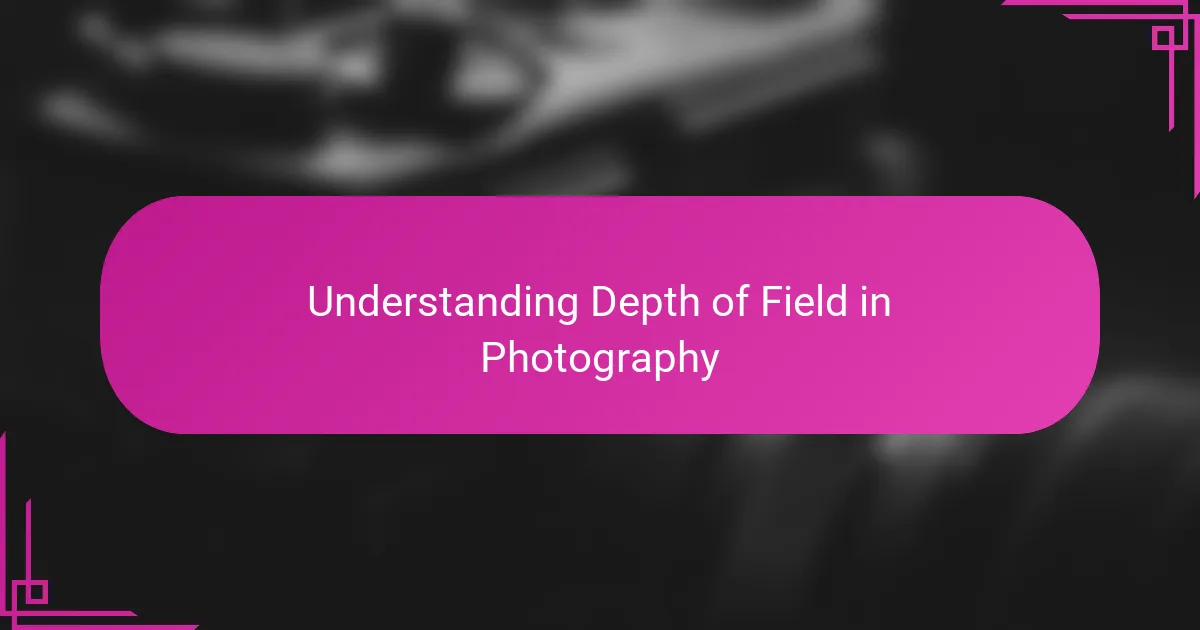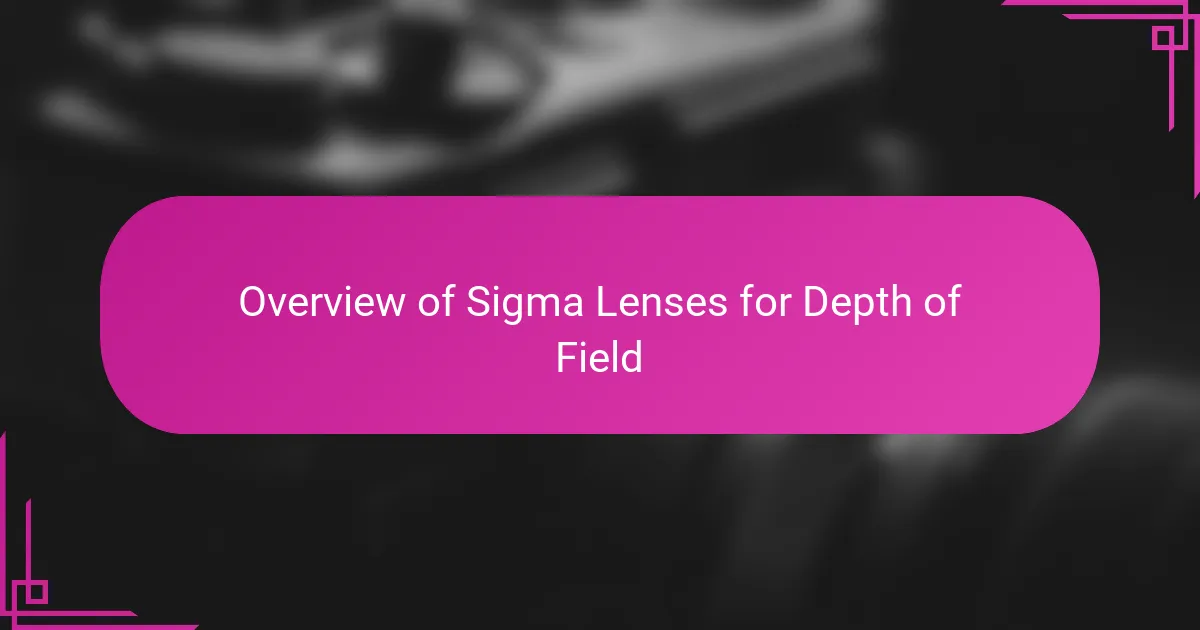Key takeaways
- Depth of field is a key creative tool in photography, influencing focus and emotional storytelling.
- Sigma lenses are highly regarded for their sharpness and beautiful bokeh, enhancing the quality of depth of field effects.
- Aperture settings significantly affect depth of field, with wider apertures isolating subjects and smaller apertures increasing focus across the scene.
- Distance from the subject and focal length are crucial factors that help achieve the desired depth of field and narrative in photographs.

Understanding Depth of Field in Photography
Depth of field has always fascinated me because it’s like the secret ingredient that controls what parts of a photo truly stand out. Have you ever wondered why some images have everything in sharp focus, while others blur the background into a creamy softness? That’s depth of field in action—deciding what the viewer’s eye is naturally drawn to.
From my experience, understanding depth of field isn’t just about the technical side; it’s about storytelling. When I first experimented with Sigma lenses, I noticed how tweaking the aperture changed the mood of a shot by shifting what remained sharp and what faded away. It made me realize that depth of field isn’t just a setting—it’s an emotional tool that helps you express your vision.
What really clicked for me was seeing how different focal lengths and apertures interact to shape depth of field. It’s like painting with light, deciding how much of the scene whispers quietly in the background versus how much shouts out in focus. This subtle power transforms ordinary shots into ones that feel alive and intentional.

Overview of Sigma Lenses for Depth of Field
When I first picked up a Sigma lens, I was curious about how it would handle depth of field compared to my previous gear. What struck me immediately was the beautifully smooth bokeh—the way the out-of-focus areas melted into softness felt almost cinematic. It made me realize that Sigma lenses are crafted with an impressive balance of sharpness and creamy backgrounds.
One of my favorite Sigma lenses for controlling depth of field has been their fast prime lenses with wide apertures. Opening up to f/1.4 or f/1.8 gave me so much creative freedom to isolate subjects, especially in low light. Have you ever noticed how a wider aperture not only lets in more light but also turns mundane backgrounds into dreamy, artistic layers? That’s the kind of magic I found with Sigma’s glass.
Sigma’s range of lenses surprised me with their consistency and quality, particularly in maintaining sharp focus where it matters while letting the rest of the scene gently fall away. It made me appreciate how a well-designed lens can elevate my storytelling by literally shaping what the viewer sees first—and what lingers quietly in the background.

How Aperture Affects Depth of Field
Aperture is really where depth of field starts to take shape in any photograph. I remember my first shoot with a Sigma 50mm f/1.4, curious about how opening up to that super wide aperture would change things. The moment I saw the background blur away, leaving the subject crisp and popping, I understood that aperture isn’t just a number—it’s a way to control attention.
Have you ever played with smaller apertures like f/8 or f/11? From my experience, stopping down the aperture increases depth of field, bringing more of the scene into focus. It feels like suddenly, the entire frame becomes part of the story instead of just one focal point. That switch from a creamy background to a sharp landscape really changes the narrative the image tells.
What fascinates me most is how aperture works together with Sigma’s lens design to craft that beautiful bokeh or razor-sharp clarity. It’s not just about light—aperture opens a creative door. When I adjust it, I’m deciding how much I want the viewer to linger on one detail or explore the whole scene. It’s a powerful tool that makes every shot more intentional.

Techniques for Using Sigma Lenses Effectively
One technique I found invaluable when using Sigma lenses is to really experiment with the aperture ring or settings to fine-tune depth of field on the fly. For instance, during a portrait session, I gradually stopped down from f/1.4 to f/2.8 and noticed how the subject remained sharp while the background softened just enough to avoid distractions. Have you ever tried this subtle dance between aperture and focus? It’s like composing music—each adjustment changes the mood.
Another trick I rely on is leveraging Sigma’s wide-angle lenses to include more of the scene in focus without sacrificing subject isolation. Shooting landscapes or environmental portraits, I often select a mid-range aperture like f/5.6 to f/8, which strikes a balance between sharpness and background separation. This approach helped me capture both intricate details and the overall atmosphere, creating images that tell a fuller story.
Finally, don’t underestimate the power of distance—moving closer or farther from your subject with Sigma lenses dramatically changes the depth of field effect. I remember at a family gathering, stepping closer with my 35mm Art lens to isolate a smile while allowing the bustling background to gently fade. It’s amazing how your physical proximity, paired with Sigma’s precise optics, can transform an ordinary moment into a compelling visual narrative. Have you noticed how changing perspective reshapes your story?

My Practical Experience with Sigma Lenses
When I first started shooting with Sigma lenses, I was genuinely impressed by how intuitive they felt in my hands. It wasn’t just about getting sharp images; it was the way these lenses responded when I adjusted the aperture—like the camera and I were having a silent conversation about depth of field. Have you ever experienced that moment when gear just clicks, letting you focus entirely on your creative vision?
One particular shoot comes to mind where I used the Sigma 85mm Art lens at f/1.4 during a golden hour portrait session. The subject’s eyes were razor-sharp, and the background melted away into the kind of velvety blur that made everything feel almost dreamlike. That experience solidified my trust in Sigma’s ability to help me use depth of field not just technically, but emotionally.
I also appreciate how Sigma lenses hold up under various lighting conditions. During a low-light event, I could open up my lens wide, confident it would deliver clean, focused images without chasing autofocus or compromising bokeh quality. This reliability has made me more adventurous with my framing and aperture choices, knowing the lens will support my creative decisions. Have you found a lens that gives you that kind of assurance? For me, Sigma ticks that box every time.

Tips for Achieving Desired Depth of Field
Getting the depth of field just right often comes down to knowing when and how to adjust your aperture. I’ve found that starting wide open, especially with Sigma’s fast primes, is like opening a door to creative possibilities—you instantly blur distractions and let your subject shine. But have you ever tried gradually stopping down to see how the focus area expands? It’s fascinating how small tweaks can shift the whole feel of a photo.
Another tip I swear by is minding your distance from the subject. In one shoot using my Sigma 35mm Art lens, stepping just a bit closer completely changed the depth of field, tightening the blur around my subject and crafting a stronger narrative. It made me realize that physical movement matters as much as lens settings, and combining the two gives you precise control over your image’s story.
Finally, don’t overlook the power of focal length when thinking about depth of field. Sigma’s range taught me that longer lenses naturally produce shallower depth of field, perfect for portraits, while wider lenses help keep more in focus for landscapes or environmental shots. Knowing when to swap lenses or zoom in can be a game-changer, making your photos feel exactly how you want them to. Have you noticed how focal length subtly directs the viewer’s eye? That’s the kind of magic I love harnessing.

Common Challenges and How to Overcome Them
One challenge I’ve often encountered with Sigma lenses is managing focus precisely when shooting wide open at apertures like f/1.4. The shallow depth of field can be unforgiving—miss the focus just slightly, and your subject’s eyes might blur instead of pop. Have you ever felt that mix of excitement and frustration as you try to nail that razor-sharp focus? For me, the key was practicing deliberate focusing techniques and sometimes using manual focus to reclaim control.
Another struggle that caught me off guard was dealing with background distractions when using fast lenses. Even though Sigma lenses create beautiful bokeh, busy or bright backgrounds can steal attention if you’re not careful. I learned that composing carefully, moving my subject, or adjusting the aperture just a bit can help tame those distractions without losing the creamy blur I love. It’s a subtle balance, like finding the right seasoning for a recipe.
Lastly, adapting to different lighting situations presented its own hurdle. Shooting in low light with a wide aperture is fantastic for depth of field, but it sometimes challenged the autofocus speed and accuracy. Have you ever hesitated, worrying your shot might miss focus in those tricky conditions? Over time, I found that pairing Sigma lenses with a camera body known for quick autofocus made all the difference, and trusting the gear allowed me to focus more on creativity than technical stress.